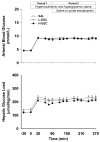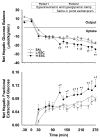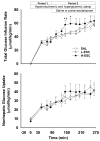Portal infusion of escitalopram enhances hepatic glucose disposal in conscious dogs
- PMID: 19326481
- PMCID: PMC2775505
- DOI: 10.1016/j.ejphar.2009.01.042
Portal infusion of escitalopram enhances hepatic glucose disposal in conscious dogs
Abstract
To examine whether escitalopram enhances net hepatic glucose uptake during a hyperinsulinemic hyperglycemic clamp, studies were performed in conscious 42-h-fasted dogs. The experimental period was divided into P1 (0-90 min) and P2 (90-270 min). During P1 and P2 somatostatin (to inhibit insulin and glucagon secretion), 4x basal intraportal insulin, basal intraportal glucagon, and peripheral glucose (2x hepatic glucose load) were infused. Saline was infused intraportally during P1 in all groups. In one group saline infusion was continued in P2 (SAL, n = 11), while escitalopram was infused intraportally at 2 microg/kg/min (L-ESC, n = 6) or 8 microg/kg/min (H-ESC, n = 7) during P2 in two other groups. The arterial insulin concentrations rose approximately four fold (to 123 +/- 8, 146 +/- 13 and 148 +/- 15 pmol/L) while glucagon concentrations remained basal (41 +/- 3, 44 +/- 9 and 40 +/- 3 ng/L) in all groups. The hepatic glucose load averaged 216 +/- 13, 223 +/- 19 and 202 +/- 12 micromol/kg/min during the entire experimental period (P1 and P2) in the SAL, L-ESC and H-ESC groups, respectively. Net hepatic glucose uptake was 11.6 +/- 1.4, 10.1 +/- 0.9 and 10.4 +/- 2.3 micromol/kg/min in P1 and averaged 16.9 +/- 1.5, 15.7 +/- 1.3 and 22.6 +/- 3.7 (P < 0.05) in the SAL, L-ESC and H-ESC groups, respectively during the last hour of P2 (210-270 min). Net hepatic carbon retention (glycogen storage) was 15.4 +/- 1.3, 14.9 +/- 0.6 and 20.9 +/- 2.6 (P < 0.05) micromol/kg/min in SAL, L-ESC and H-ESC respectively during the last hour of P2. Escitalopram enhanced net hepatic glucose uptake and hepatic glycogen deposition, showing that it can improve hepatic glucose clearance under hyperinsulinemic hyperglycemic conditions. Its use in individuals with diabetes may, therefore, result in improved glycemic control.
Figures



Similar articles
-
Portal infusion of a selective serotonin reuptake inhibitor enhances hepatic glucose disposal in conscious dogs.Am J Physiol Endocrinol Metab. 2004 Dec;287(6):E1057-63. doi: 10.1152/ajpendo.00313.2004. Epub 2004 Aug 17. Am J Physiol Endocrinol Metab. 2004. PMID: 15315909
-
Interaction of a selective serotonin reuptake inhibitor with insulin in the control of hepatic glucose uptake in conscious dogs.Am J Physiol Endocrinol Metab. 2005 Mar;288(3):E556-63. doi: 10.1152/ajpendo.00405.2004. Epub 2004 Nov 2. Am J Physiol Endocrinol Metab. 2005. PMID: 15522992
-
Portal 5-hydroxytryptophan infusion enhances glucose disposal in conscious dogs.Am J Physiol Endocrinol Metab. 2005 Aug;289(2):E225-31. doi: 10.1152/ajpendo.00614.2004. Epub 2005 Mar 8. Am J Physiol Endocrinol Metab. 2005. PMID: 15755767 Free PMC article.
-
Small amounts of fructose markedly augment net hepatic glucose uptake in the conscious dog.Diabetes. 1998 Jun;47(6):867-73. doi: 10.2337/diabetes.47.6.867. Diabetes. 1998. PMID: 9604861
-
Hepatic portal venous delivery of a nitric oxide synthase inhibitor enhances net hepatic glucose uptake.Am J Physiol Endocrinol Metab. 2008 Apr;294(4):E768-77. doi: 10.1152/ajpendo.00184.2007. Epub 2008 Jan 22. Am J Physiol Endocrinol Metab. 2008. PMID: 18212022
Cited by
-
Serotonergic Control of Metabolic Homeostasis.Front Cell Neurosci. 2017 Sep 20;11:277. doi: 10.3389/fncel.2017.00277. eCollection 2017. Front Cell Neurosci. 2017. PMID: 28979187 Free PMC article. Review.
-
Treatment with an SSRI antidepressant restores hippocampo-hypothalamic corticosteroid feedback and reverses insulin resistance in low-birth-weight rats.Am J Physiol Endocrinol Metab. 2010 May;298(5):E920-9. doi: 10.1152/ajpendo.00606.2009. Epub 2010 Jan 26. Am J Physiol Endocrinol Metab. 2010. PMID: 20103738 Free PMC article.
-
Hepatic glycogen supercompensation activates AMP-activated protein kinase, impairs insulin signaling, and reduces glycogen deposition in the liver.Diabetes. 2011 Feb;60(2):398-407. doi: 10.2337/db10-0592. Diabetes. 2011. PMID: 21270252 Free PMC article.
-
Escitalopram Ameliorates Cardiomyopathy in Type 2 Diabetic Rats via Modulation of Receptor for Advanced Glycation End Products and Its Downstream Signaling Cascades.Front Pharmacol. 2020 Dec 15;11:579206. doi: 10.3389/fphar.2020.579206. eCollection 2020. Front Pharmacol. 2020. PMID: 33384599 Free PMC article.
-
Hepatic glycogen can regulate hypoglycemic counterregulation via a liver-brain axis.J Clin Invest. 2016 Jun 1;126(6):2236-48. doi: 10.1172/JCI79895. Epub 2016 May 3. J Clin Invest. 2016. PMID: 27140398 Free PMC article.
References
-
- Adkins-Marshall B, Pagliassotti MJ, Asher JR, Connolly CC, Neal DW, Williams PE, Myers SR, Hendrick GK, Adkins RB, Jr, Cherrington AD. Role of hepatic nerves in response of liver to intraportal glucose delivery in dogs. Am J Physiol. 1992;262:E679–686. - PubMed
-
- Ahren B, Dunning BE, Havel PJ, Veith RC, Taborsky GJ., Jr Extraction of epinephrine and norepinephrine by the dog pancreas in vivo. Metabolism. 1988;37:68–73. - PubMed
-
- An Z, Dicostanzo CA, Moore MC, Edgerton DS, Dardevet DP, Neal DW, Cherrington AD. Effects of the nitric oxide donor SIN-1 on net hepatic glucose uptake in the conscious dog. Am J Physiol Endocrinol Metab. 2008;294:E300–306. - PubMed
-
- Bajaj M, Berria R, Pratipanawatr T, Kashyap S, Pratipanawatr W, Belfort R, Cusi K, Mandarino L, DeFronzo RA. Free fatty acid-induced peripheral insulin resistance augments splanchnic glucose uptake in healthy humans. Am J Physiol Endocrinol Metab. 2002;283:E346–352. - PubMed
-
- Basu A, Basu R, Shah P, Vella A, Johnson CM, Jensen M, Nair KS, Schwenk WF, Rizza RA. Type 2 diabetes impairs splanchnic uptake of glucose but does not alter intestinal glucose absorption during enteral glucose feeding: additional evidence for a defect in hepatic glucokinase activity. Diabetes. 2001;50:1351–1362. - PubMed
Publication types
MeSH terms
Substances
Grants and funding
LinkOut - more resources
Full Text Sources
Research Materials
Miscellaneous

